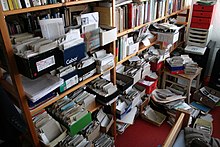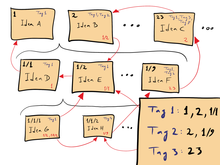 Global Information
Global InformationZettelkasten information


A Zettelkasten (German: 'slipbox', plural Zettelkästen) or card file consists of small items of information stored on Zettels (German: 'slips'), paper slips or cards, that may be linked to each other through subject headings or other metadata such as numbers and tags.[1][2] It has often been used as a system of note-taking and personal knowledge management for research, study, and writing.[3]
In the 1980s, the card file began to be used as metaphor in the interface of some hypertextual personal knowledge base software applications such as NoteCards.[4][5][6][7][8] In the 1990s, such software inspired the invention of wikis.[9]
- ^ Moeller, Hans-Bernhard (1989) [1971]. "Perception, Word-Play, and the Printed Page: Arno Schmidt and his Poe Novel". In Matuz, Roger (ed.). Contemporary Literary Criticism: Excerpts from Criticism of the Works of Today's Novelists, Poets, Playwrights, and Other Creative Writers. Vol. 56. Detroit; London: Gale Research. p. 392. ISBN 978-0-8103-4430-3. ISSN 0091-3421.
'Zettel' is German for an index card, and a 'Zettelkasten' is a writer's index card file. Schmidt prepared for Zettels Traum with a collection of more than 100,000 index cards in his legendary card file.
- ^ Eco, Umberto (2015) [1977]. "The Work Plan and the Index Cards". How to Write a Thesis. Translated by Caterina Mongiat Farina and Geoff Farina. Cambridge, MA: MIT Press. pp. 107–144. doi:10.7551/mitpress/10029.003.0008. ISBN 978-0-262-52713-2. JSTOR j.ctt17kk9g5.10. OCLC 897401730. A book on the same topic published a decade earlier was: Teitelbaum, Harry (1966). "Note-taking". How to Write Theses: A Guide to the Research Paper. Monarch Notes and Study Guides. Vol. 888–8. New York: Distributed by Monarch Press. pp. 29–39. ISBN 978-0-671-18726-2. OCLC 189085.
- ^ Mattern, Shannon (December 2020). "The Spectacle of Data: A Century of Fairs, Fiches, and Fantasies". Theory, Culture & Society. 37 (7–8): 133–155 (146). doi:10.1177/0263276420958052. S2CID 225124110.
Over the decades, cards put to personal use have provided aesthetic and intellectual inspiration to myriad artists, writers, and designers.
- ^ Conklin, Jeff (September 1987). "Hypertext: An Introduction and Survey" (PDF). Computer. 20 (9): 17–41. doi:10.1109/MC.1987.1663693. S2CID 9188803. Archived (PDF) from the original on 2017-08-13.
One kind of manual hypertext is the traditional use of 3×5 index cards for note taking. Note cards are often referenced to each other, as well as arranged hierarchically (for example, in a shoebox or in rubber-banded bundles). A particular advantage of note cards is that their small size modularizes the notes into small chunks. The user can easily reorganize a set of cards when new information suggests a restructuring of the notes. ... Perhaps the best known version of full hypertext [software] is the NoteCards system developed at Xerox PARC.
- ^ Neuwirth, Christine; Kaufer, David; Chimera, Rick; Gillespie, Terilyn (November 1987). "The Notes Program: A Hypertext Application for Writing from Source Texts". HYPERTEXT '87: Proceedings of the ACM Conference on Hypertext: November 13–15, Chapel Hill, North Carolina. New York: Association for Computing Machinery. pp. 121–141. doi:10.1145/317426.317437. ISBN 978-0-89791-340-9. OCLC 612420419.
The Notes program has an analog in earlier technology: 3×5 note cards. The following section, which outlines some key components in the writing process, lays the theoretical groundwork for exploring the benefits of note cards for writers, the limitations of conventional note cards, and the expected benefits of computer-based note cards. ... At least one of the general network-based editors, NoteCards, could probably be specialized to support the task-optimized linking of the Notes program.
- ^ Halasz, Frank G. (July 1988). "Reflections on NoteCards: Seven Issues for the Next Generation of Hypermedia Systems". Communications of the ACM. 31 (7): 836–852. doi:10.1145/48511.48514.
NoteCards was designed to help people work with ideas. Its intended users are authors, researchers, designers, and other intellectual laborers engaged in analyzing information, constructing models, formulating arguments, designing artifacts, and generally processing ideas. The system provides the user with a network of electronic notecards interconnected by typed links. ... Fileboxes are specialized cards that can be used to organize or categorize large collections of notecards.
- ^ Lin, Liang-Yi (1989). Learning to Use Hypertext Systems with Metaphors: An Interface Design Perspective (Ed.D. thesis). Urbana, IL: University of Illinois at Urbana-Champaign. ISBN 979-8-207-82289-1. OCLC 23103660. ProQuest 303766704.
NoteCards provides the user with a "semantic network" of electronic notecards interconnected by typed links. This network serves as a medium in which the user can represent collections of related ideas. It also functions as a structure for organizing, storing, and retrieving information. In the NoteCards system, a note card is an electronic generalization of the 3 by 5 paper note card. ... Links are used to interconnect individual note cards into networks or structures of related cards. ... The note card metaphor embodied some of the important elements of hypertext systems which the book metaphor did not have.
- ^ Nielsen, Jakob (1995). "NoteCards (1985)". Multimedia and Hypertext: The Internet and Beyond. Boston: AP Professional. pp. 47–50. ISBN 978-0-12-518408-3. OCLC 31709144.
NoteCards may be the most famous of the original hypertext research systems ... Each node is a single notecard ... The links are typed connections between cards.
- ^ Leuf, Bo; Cunningham, Ward (2001). The Wiki Way: Quick Collaboration on the Web. Boston: Addison-Wesley. pp. 15, 365. ISBN 978-0-201-71499-9. OCLC 45715320.
Ward called it 'the simplest online database that could possibly work'. In 1994, he wanted a quick way to collaboratively publish software patterns on the Web. Ideas that had developed from his work with program development and HyperCard stacks went into it, and the first 'wiki server' was born. ... Wiki shares some history with the use of index cards in object-oriented programming. Both Wiki and CRC Cards credit an unpublished HyperCard stack as their common ancestor.